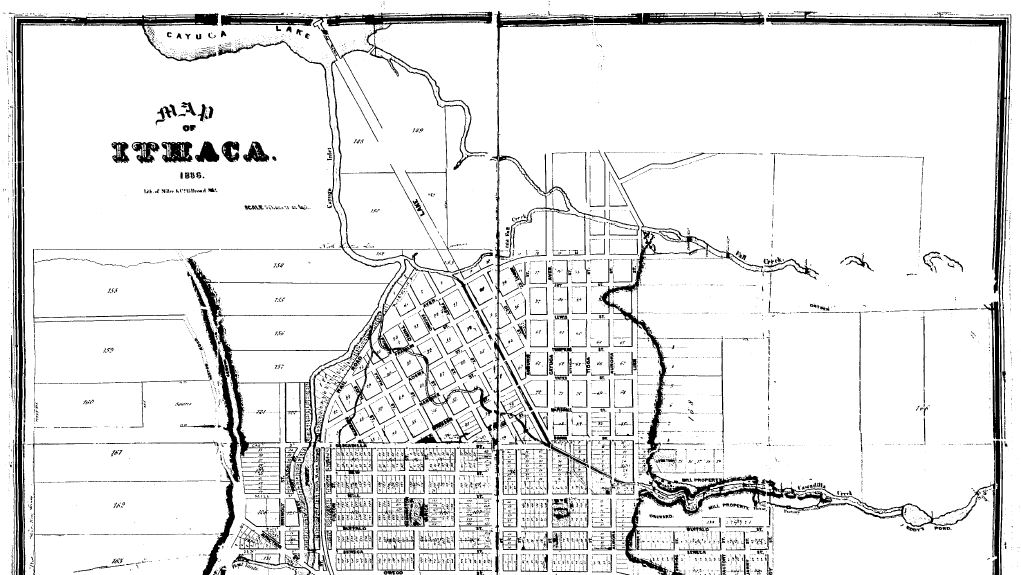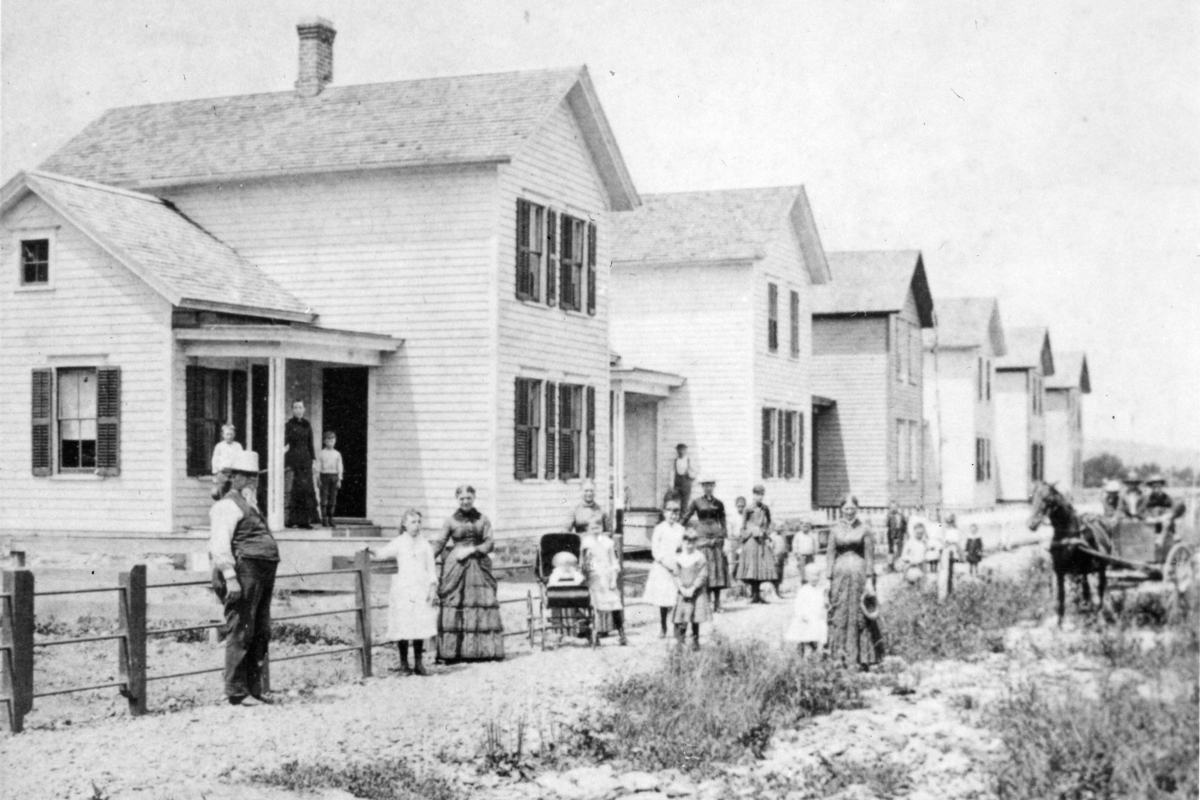By Patricia Longoria

On the northwestern edge of Ithaca’s Fall Creek neighborhood, a turn from busy State Route 13 (North Meadow Street) leads to tree-lined Dey Street. Only three blocks long, the street has a relaxed, neighborhood vibe. Its tidy late-Victorian homes sit close to the street on narrow lots.

At one end, where Dey Street and Auburn Street meet at an acute angle, a V-shaped pocket park offers a shaded reminder to slow down and enjoy the day. On an early spring afternoon, kids play a game of baseball. Younger children shriek happily as they launch from a swing and climb on the play structure.
A three-story brick building, once home to the Ithaca Calendar Clock Company, dominates the block across from the park. The former factory currently houses a music store. From it drift the high squeak of a music student’s brass instrument and a jazz duo’s low bass strum.
Manhattan’s Dey Street
More than 200 miles southeast of Ithaca, in the heart of Manhattan’s Financial District, another street carries the same name. Dey Street runs between Broadway and Church Street just a stone’s throw from the World Trade Center. The narrow thoroughfare is only a block long. Much of the street’s pedestrian traffic flows underground through the Dey Street Concourse, where commuters can access multiple subway and rail lines.[1]
Though hundreds of miles apart, both streets were named for the Dutch Dey family who arrived in colonial New Amsterdam in the seventeenth century. The Deys were politically and socially prominent landowners and merchants. By 1750, Manhattan’s Dey Street was laid out as a rural road bisecting the Dey family’s five-and-a-half acre farm.[2] The property extended to the Hudson River.
Jane Dey (1728-1810) and her husband John Varick (1730-1809) inherited several lots along Dey Street in 1764.[3] It was the Varicks’ daughter Jane who made the Dey family’s Ithaca connection.
In 1799, Jane Dey Varick Hardenberg (1760-1808), by then a widow,[4] married New York Surveyor General Simeon DeWitt (1756-1834), himself a widower. The couple lived in Albany, but by the time of their marriage DeWitt owned more than 1,000 acres in Ithaca, then known as Ulysses (Military Tract township Number 22).[5]
Ithaca’s Dey Street is Named
At the end of 1834, Simeon DeWitt died in Ithaca. Richard Varick DeWitt (1800-1868)[6]—Simeon DeWitt and Jane Varick DeWitt’s oldest son—managed the sale of his father’s extensive Ithaca property. Richard, along with two other commissioners, divided the DeWitt estate into lots.
They laid out and named a host of new streets in what would later become Ithaca’s Northside and Fall Creek neighborhoods. The prosaic First through Seventh streets paralleled Cascadilla Creek. The Founding Father streets included Franklin, Adams, Hancock, and Madison. The New York state governor streets of Yates, Tompkins, and Lewis were sandwiched between streets named for first Supreme Court Chief Justice John Jay and fourth Chief Justice John Marshall. The resulting 1836 map was the first to show Dey Street named and laid out, running diagonally to Railroad Avenue and next to the aptly named Short Street.

Dey Street and some of the other roads in the new section of Ithaca deviated from the north-south and east-west orientation of older streets. But, for the most part, Richard followed his father’s surveying model, with an ordered, grid-like pattern of streets.
On an earlier map made in 1831, Simeon DeWitt had acknowledged his wife’s father’s family by naming Varick Street (now Park Place) along a public park. Richard’s uncle and namesake, Richard Varick (1753-1831), was mayor of New York City in the first decade after American independence.
Similarly, Richard chose to recognize his mother’s Dey ancestors with the naming of Dey Street. The names of political figures imbued the raw, young village’s planned streets—most of them rough dirt tracks—with a sense of patriotism and history. The Dey name evoked Revolutionary War heroes and leaders of the early republic.
Thus mapped, Dey Street in Ithaca marked the legacy of a Dutch American family whose members fought to build a new nation and invested in (gambled on?) an upstate New York region brimming with confidence in its future prosperity.
However, Richard Varick DeWitt and the investors who purchased his father’s lots could not have known that this optimism would soon be challenged. The Panic of 1837 touched off a decades-long financial recession that depressed real estate prices and forced some of the DeWitt estate buyers into bankruptcy. It would be almost four decades before Dey Street buzzed with the electric energy of a successful commercial enterprise when the Ithaca Calendar Clock Company built its three-story brick factory there at the start of Ithaca’s industrial boom.


Most of the first residents were families of men employed at the Ithaca Glass Works at Third and Franklin streets.
 Patricia Longoria is deputy historian of the Village of Cayuga Heights and coordinator of the Names on the Land–Tompkins County project. Pat has been an editor and writer in educational publishing for more than two decades. Her archival research and graduate training in Latin American history translate surprisingly well to deciphering the spidery handwriting on old property deeds, puzzling out the family trees of early Tompkins County residents, and finding names on historical maps.
Patricia Longoria is deputy historian of the Village of Cayuga Heights and coordinator of the Names on the Land–Tompkins County project. Pat has been an editor and writer in educational publishing for more than two decades. Her archival research and graduate training in Latin American history translate surprisingly well to deciphering the spidery handwriting on old property deeds, puzzling out the family trees of early Tompkins County residents, and finding names on historical maps.
ENDNOTES
[1] “Fulton Center Connection to World Trade Center PATH Station to Open Thursday; New Access Point Links 9 Subway Lines with Port Authority Trans-Hudson Rail Service,” MTA Press Release, May 25, 2016.
[2] Treman, Ebenezer Mack. History of the Treman, Tremaine, Truman Family, Vol. 1, Press of the Ithaca democrat, Ithaca, 1901, pp. 743-744 and pp. 755-756.
[3] “Abstracts of Wills on File in the Surrogate’s Office, City of New York, Vol. VI, 1760-1766, With Letters of Administration Granted 1760-1766,” in “Collections of the New-York Historical Society for the Year 1897,” New York, 1897, pp. 321-322.
[4] “DIED, in this city, in the 37th year of his age, Maj. Abraham Hardenberg, one of the officers of the late American army.” Columbian Gazetteer, New York, New York, October 13, 1794. Birth and death dates for Jane V.H. DeWitt confirmed in Reynolds, Cuyler (ed.). Hudson-Mohawk Genealogical and Family Memoirs, Vol. 1, Lewis Historical Publishing Company, New York, 1911, p. 366. (Same source says that Jane was the sister of Revolutionary War Colonel Richard Varick, who served as mayor of New York.) Death date confirmed in U.S., Newspaper Extractions from the Northeast, 1704-1930. Find A Grave lists her birth date incorrectly as 1784 and death date as 1808. New Jersey, Marriage Records, 1683-1802 lists her marriage to Abraham Hardenburgh (Ulster, NY) as 22 January 1784. US, Newspaper Extractions from the Northeast, 1704-1930: “Hardenberg, Abraham, Maj., officer of American Army, d. at New York (C.C. Oct. 18, 1794).” The Seward Family Digital Archive includes Jane, “d. 1808, widow of Abraham Hardenbergh [1756-1794].” https://sewardproject.org/person-public-fields/5270.
[5] Heidt, William. Simeon DeWitt; Founder of Ithaca, DeWitt Historical Society of Tompkins County, Ithaca, 1968, p. VII and pp. 21-23.
[6] Treman, p. 791.






 Deborah J. Martin-Plugh is the 3rd-great-granddaughter of Peter Van Dorn and Mary Irwin and author, contributing writer, historian, and genealogical researcher. Born in Ithaca, New York, Martin-Plugh has roots that run deep in Tompkins County, including pioneer settler ancestors Peter Van Dorn, Samuel Weyburn, Samuel Ingersoll, Lewis Purdy, Dr. Parvis Austin Williams, Ira Smith, John Learn, John R. Case, John Bowker, and Jacob Powers. Genealogy without history is just a list of names and dates, and so Deborah’s blog was born to tell the story:
Deborah J. Martin-Plugh is the 3rd-great-granddaughter of Peter Van Dorn and Mary Irwin and author, contributing writer, historian, and genealogical researcher. Born in Ithaca, New York, Martin-Plugh has roots that run deep in Tompkins County, including pioneer settler ancestors Peter Van Dorn, Samuel Weyburn, Samuel Ingersoll, Lewis Purdy, Dr. Parvis Austin Williams, Ira Smith, John Learn, John R. Case, John Bowker, and Jacob Powers. Genealogy without history is just a list of names and dates, and so Deborah’s blog was born to tell the story: